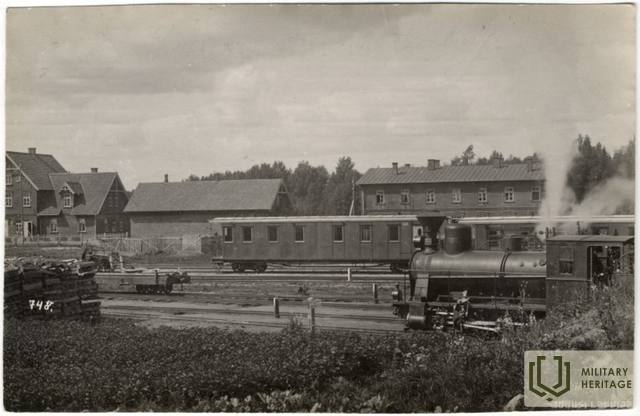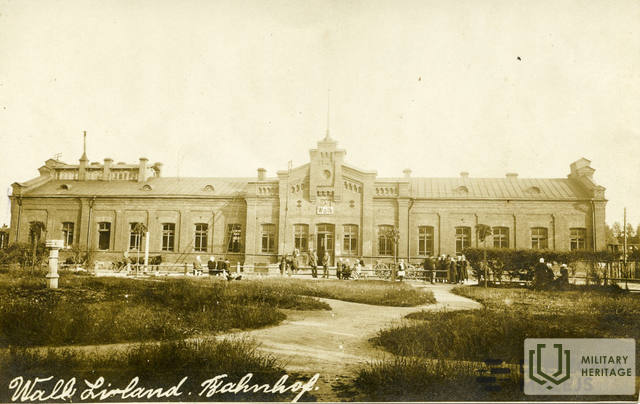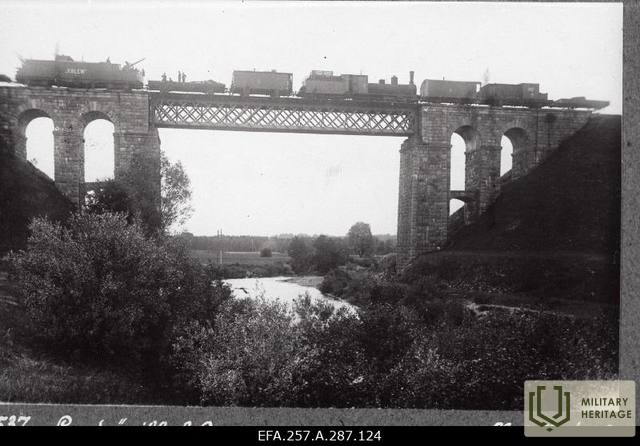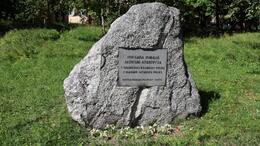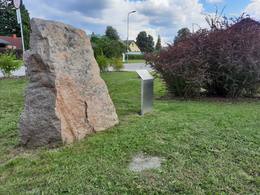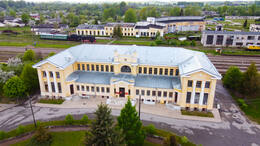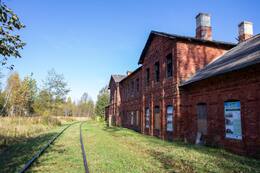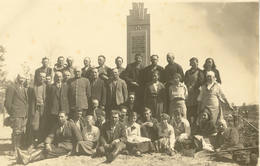About the Latvian War of Independence and the events of 1919 in Aluksne
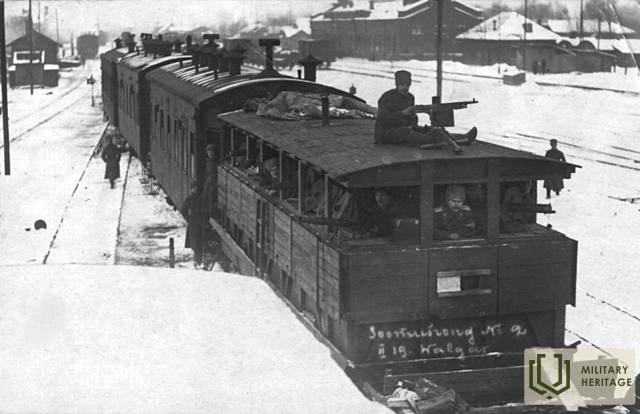
On March 27, 1919, the 1st Valmiera Infantry Regiment, together with the Estonian bodyguard Tallinn (then Rēvele) and Tērbata battalions, as well as three armed trains from the banks of the Melnupe, began the liberation of Latvia from the Bolsheviks.
“During the freedom fights, the Gulbene-Valka narrow-gauge railway was handed over to the Estonian army. It was used only for military purposes, including the movement of armored trains.
The armored trains were perfectly equipped: armed with two small-caliber weapons, 8 machine guns, rifles, they consisted of up to 15 wagons. There were amphibious units, up to 200 people. The train was "towed" by two new American locomotives. "
Matson's memories. Collection of Aluksne Museum. ANM 2387.
A story of memories written by the Aluksne Museum on November 21, 1965.
Related timeline
Related topics
Related objects
Memorial stone to the liberators of Alūksne
Located in Alūksne, at the intersection of Helēnas and Alsviķu streets.
The memorial stone was unveiled on May 29, 1999, the 80th anniversary of the liberation of Alūksne. The stone forging was performed by the sculptor Ainārs Zelčs.
On March 31, 1919, a Northern Latvian brigade was founded in Tartu to liberate Vidzeme and Latgale. The brigade consisted of the combined 1st Valmiera and 2nd Cēsis Infantry Regiment, later also the Northern Latvian Partisan Regiment, two cavalry squadrons and two artillery batteries. On May 26, these forces occupied Valmiera, but on May 27, the 1st Valmiera Infantry Regiment together with the 2nd Estonian Cavalry Regiment attacked in the direction of Alūksne. The Bolsheviks were unable to repel further attacks and on May 29, 1919, Aluksne was liberated.
Memorial stone to the Finnish Volunteer Regiment "Boys of the North"
Located in Alūksne, Jāņkalna Street 52, near Alūksne Narrow Gauge Railway Station.
On February 23, 2019, to mark the centenary of the Latvian War of Independence, a special memorial was created at the initiative of the Association of Independence Fighting Traditions (Finland) to honor the fallen Finnish volunteers, with a special boulder and information board. The memorial stone to Alūksne was removed from the Salpa line in Finland, which was built in 1940-1944. to protect the eastern border of Finland. The 1,200 km long Salpa line is one of the most important lines of defense in independent Finland, as well as one of the strongest and best-preserved defenses of its kind in Europe since World War II.
The stone brought to Aluksne symbolizes the struggle for independence of two nations - the Finns and the Latvians. A group of Finnish volunteers "Northern Boys" went to help Latvians protect the freedom of the new Latvian state. On February 21, 1919, the "Northern Boys" took part in fierce battles around Alūksne (Marienburg). After a five-hour battle at Alūksne railway station, the Finns occupied Alūksne. 23 Finnish volunteers were killed and many injured in the fight.
Gulbene Railway Station
The Gulbene Railway Station is located in the city of Gulbene. During World War I, in 1916 to 1917, the narrow-gauge railway line to Pļaviņas was reconstructed to 1,524 mm width to ensure that it can serve as a connection to the Rīga-Daugavpils line. In addition, a railway line to Ieriķi and to Sita was constructed, thereby establishing a connection with Pytalovo. As a result, Gulbene became a railway hub. The current station building by architect Pēteris Feders was constructed in 1926. During the War of Independence, on 31 May 1919, when Gulbene was liberated from the Bolsheviks, the 1st (4th) Valmiera Infantry Regiment collected a significant number of war trophies here. On 14 June 1941, both civilians and Latvian Army officers arrested in the Litene Summer Camp were deported from the Gulbene Railway Station. As a key hub, it was bombed in the spring of 1944. After the war, it was restored to its original form. An educational and interactive centre named ‘Railway and Steam’ was opened in 2018. Next to the Gulbene station is the company SIA Gulbenes – Alūksnes bānītis, which offers interactive lessons and tours. Visitors have access to the station building and platform, a memorial plaque and a monument to the repressed ones by sculptor Indulis Ranka.
Valka train station
The Valka Railway Station is located at the end of Poruka street, next to a set of train tracks that are out of use. The station building can only be viewed from the outside where information stands of the importance of the railway in Valka and Valga are in place. Near the station building is a memorial stone devoted to the people deported to Siberia on 14 June 1941. The station building was constructed around 1896-1897. Narrow-gauge railway lines in the Valka-Rūjiena-Pärnu section were put in place here initially. During World War I, the railway was severely damaged. After establishing the state border, the Valka Railway Station (Valka II) became a border station. In late September 1920, the special Railway Board Commission arrived in Valka. The commission was authorised to negotiate and conclude an agreement with Estonia on the transfer of passengers from the station of one state to the other. The tracks between the triangularly placed Lugaži, Valka and Valga stations were strategically important, as they allowed armoured trains to turn around and move in the opposite direction. During the Soviet period, the USSR Army used this station to deliver ballistic missiles to Valka. A mass deportation of the Latvian people to the inland areas of the USSR took place on the night of 13-14 June 1941. More than 90 people from Valka and the surrounding areas were put in cattle waggons to be deported from the Valka Railway Station without any court judgement, prior warning or explanations. In September 1944, the station was destroyed by the retreating German Army.
Monument to the soldiers of Anna Parish who died in the First World War and the Latvian Liberation War
Located in the central part of Anna parish Ezeriņi cemetery.
In the cemetery, where the burials have been made since 1925, there is a monument to the soldiers of Anna Parish who died in the First World War and the Latvian Liberation War, built with the funds collected by the Department of Guard of Anna Parish and unveiled in 1933. Until the Second World War, the guards of Anna Parish took care of the care of the monument, who went to the cemetery every Sunday and laid flowers in honor of the fallen. On November 18, 1940, the monument was shot, and the footprints of the bullets are still visible. Today, the cemetery commemorates Lāčplēsis Day every year.
In 2004, a memorial to the politically repressed in 1941 and 1949 was unveiled in the cemetery, and in 2006 a memorial plaque to the national partisans was unveiled.




